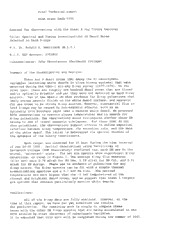
NASA Technical Reports Server (NTRS) 20000117681: Spectral and Timing Investigations of Dwarf Novae Selected in Hard X-Rays PDF
Preview NASA Technical Reports Server (NTRS) 20000117681: Spectral and Timing Investigations of Dwarf Novae Selected in Hard X-Rays
Final Technical report NASA Grant NAG5-7375 Awarded for observations with the Rossi X-ray Timing Explorer Title: Spectral and Timing Investigations of Dwarf Novae Selected in Hard X-rays P.I. Dr. Ronald A. Remillard (M.I.T.) M.I.T. OSP Account: 6703800 CoInvestigator: John Thorstensen (Dartmouth College) Summary of the Investigation and Results: There are 9 dwarf novae (DN) among the 43 cataclysmic variables (accreting white dwarfs in close binary systems) that were detected during the HEAO-I all-sky X-ray survey (1977-1979). On the other hand, there are roughly one hundred dwarf novae that are closer and/or optically brighter and yet they were not detected as hard X-ray sources. Two of the HEAO-I DN show evidence for X-ray pulsations that imply strong magetic fields on the white dwarf surface, and magnetic CVs are known to be strong X-ray sources. However, substantial flux in hard X-rays may be caused by non-magnetic effects, such as an optically thin boundary layer near a massive white dwarf. We proposed RXTE observations to measure plasma temperatures and to search for X-ray pulsations. The observations would distinguish whether these DN belong to one of (rare) magnetic subclasses. For those that do not show pulsations, the observations support efforts to define empirical relations between X-ray temperature, the accretion rate, and the mass of the white dwarf. The latter is determined via optical studies of the dynamics of the binary constituents. Each target was observed for 15 ksec during the time interval of Jan 24-28 1998. Optical observations using faciltities of Dartmouth College (MDM Observatory) confirmed that each DN was in the normal, "quiescent" state. The net PCA spectra show significant X-ray detections, as shown in Figure i. The average X-ray flux measures (2-20 keV) were 0.78 mCrab for SU Uma, 0.59 mCrab for WW Cet, and 0.51 mCrab for SS Auriga. There was no evidence of pulsations for any X-ray source. The X-ray spectra can be fit with a simple thermal bremsstrahlung spectrum and a 6.7 keV Fe line. The derived temperatures are much higher than the -3 keV temperatures of the closest and brightest dwarf novae, and we suggest that these 3 targets are systems that contain particularly massive white dwarfs. Publications: All of the X-ray data are fully analyzed. However, at the time of this report, we have not yet submitted the results for publication. The remaining work is simply to compare these cases with the other DN X-ray spectra that are being accumulated in the RXTE archive by other observers of cataclysmic variables. It is expected that this work will be completed during the suntmer of 2001. 10-3 ' I ' I ' I ' I I 10-4 i0-5 r \ I I I 10-6 I I i0-7 2 4 6 8 10 20 10-3 ' I ' I ' I ' I I > Q_ m_ 10 -4 _l E o 10 -5 ww Cet /z" o i0-6 78 keY 1 © / , I ,! I , 11 , 1 I 10-7 2 4 6 8 10 2O 10-3 ' I ' I ' I ' I I0-4 10-5 f \ SS Aur / I 10-6 11.2 keY I I I i II LII , I I 10-7 2 4 6 8 10 2O Photon Energy (keY)
